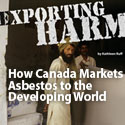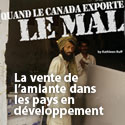McGill University is carrying out an internal investigation as to whether the asbestos industry influenced the research and activities of Prof. Corbett McDonald, former Chair of McGill’s Department of Epidemiology. The Quebec Asbestos Mining Association funded and approved the research.
Below is a letter sent to McGill documenting examples of asbestos industry influence.
March 30, 2012
Dear Prof. Fuhrer and Dean Eidelman,
We trust that both of you, McGill’s Department of Epidemiology and McGill University care about the impact in the real world of the work carried out by McGill professors of epidemiology. In particular, we assume that you both have an ethical commitment that this work must be aimed at advancing the right to health and the right to safe working conditions and certainly not at undermining the right to health and the right to safe working conditions. It is particularly disturbing, we think you would agree, when efforts to undermine the right to health and the right to safe working conditions seem linked to efforts to advance financial profits and vested interests of a particular industry, in this case the asbestos industry.
We wish to request that you review the disturbing facts listed below. We will be happy to provide documentation. This documentation directly contradicts statements made by Dean Eidelman.
Yours sincerely,
Kathleen Ruff
Dr Fernand Turcotte
1) Prof. McDonald working to prevent improved health & safety regulations
Prof. McDonald, presenting himself as the Chairman of the Department of Epidemiology and Health of McGill University, intervened in government hearings in another country to oppose improved safety standards to protect workers in that country from harm from asbestos. In 1972, Prof. McDonald testified before hearings of the U.S. Occupational Safety & Health Administration, arguing against the proposal by the U.S. National Institute for Occupational Safety and Health (NIOSH) to improve the U.S. regulation so that, instead of being exposed to 5 fibres of asbestos per cubic centimetre of air (5 f/cc), workers would only be allowed to be exposed to 2 f/cc. NIOSH made this recommendation in light of the significant evidence at the time that exposure above 2 f/cc presented a grave threat to health and would cause numerous deaths of workers. It should be noted that the efforts of the asbestos industry and Prof. McDonald at the OSHA hearings were successful in preventing improved safety protections for workers’ health and, to the satisfaction of the asbestos industry, the NIOSH proposal was rejected and the permitted exposure level remained at 5 f/cc (more than double the 2 f/cc limit in effect in the UK at that time and 50 times higher than the permitted exposure level of 0.1 f/cc permitted in the U.S. today). Prof. McDonald, in fact, argued for, if anything, worsening the U.S. occupational health & safety regulation, saying that the standard for chrysotile mines and mills should be somewhere between 5 and 9 f/cc. It is extremely disturbing, and in our view indefensible, for the Chairman of the McGill Department of Epidemiology to intervene in another country to oppose improvements in safety protections for workers.
2) Prof. McDonald denying his connections with the asbestos industry
Prof. McDonald specifically denied, when he testified at the OSHA hearings that he had any connection whatsoever with the asbestos industry, saying “I do not work, nor am I associated with any asbestos producer or manufacturer”. He was at that time working extremely closely with Johns-Manville and the Quebec Asbestos Mining Association and was receiving a large amount of funding from the asbestos industry for research projects they approved. It is extremely disturbing, and in ourview indefensible, for the Chairman of the McGill Department of Epidemiology to give false information at a government hearing and to cover up his close connection with the asbestos industry.
3) Prof. McDonald presenting an asbestos industry front organisation as a legitimate scientific institute
When challenged regarding his denial of any connection with the asbestos industry, Prof. McDonald stated at the OSHA hearing that “Johns-Manville together with other mining companies, helps support the Institute of Occupational and Environmental Health, which is a granting body that receives research applications and which therefore indirectly supports our research”. One would understand this to mean that the Institute of Occupational and Environmental Health is a bona fide, independent scientific institute, dedicated to the pursuit of research, uncontaminated by vested financial interests. Instead, as Prof. McDonald knew, the Institute of Occupational and Environmental Health was an industry front organisation. Please note below who were the board members of the Institute of Occupational and Environmental Health:
Board members of the Institute of Occupational and Environmental Health
Karl V. Lindell, Chairman
(Chairman of the Board; Canadian Johns-Manville Co., Limited)
Michael J. Messel, Member
(President, Lake Asbestos of Quebec, Limited)
W.W. Oughtred, Member
(Executive Vice-President, Asbestos Corporation Limited)
Parker Smith, Member
(Vice-President, Bell Asbestos Mines Limited)
4) Prof. McDonald conspiring with Johns-Manville and the asbestos industry to cover up evidence of asbestos harm
Dr Irving Sekikoff is recognized worldwide as the leading scientist who challenged the misinformation of the asbestos industry and exposed the fact that, in Quebec and elsewhere, workers were in large numbers being harmed by asbestos. Dr Selikoff was alarmed by the fact that a medical doctor employed by Turner Brothers, a major asbestos company, had reported that only 7 or 8% of X-rays of workers lungs showed abnormalities, whereas a subsequent analysis by Dr Hilton Lewinsohn showed 40% to 50% of workers had lung abnormalities just a few years later at the same facility. UK asbestos regulations were based on the earlier, low statistic and the new evidence threatened, from the asbestos industry’s viewpoint, to lead to a demand for more stringent regulations with lower exposure levels in both the UK and the US. Dr Selikoff publicly raised the alarm over the new disturbing evidence & called for the OSHA 5 f/cc standard to be immediately reconsidered. The asbestos industry was furious and attacked Dr Selikoff. Instead of supporting Dr Selikoff’s call for a thorough examination of the disturbing statistics, Prof. McDonald supported the asbestos industry’s efforts to cover up the disturbing evidence and encouraged its attack on Selikoff.
5) Prof. McDonald stating that his research regarding the Quebec miners was initiated at the request of the Canadian government and that it had no connection with the asbestos industry
In published articles and in media interviews, Prof. McDonald asserted that his asbestos research was initiated at the request of the Canadian government and that it had no connection with the asbestos industry. In fact, however, in a letter of November 27, 1964, Prof. McDonald, on his own personal behalf, solicited Johns-Manville Corporation to carry out the research project. His proposal was discussed by Karl V. Lindell, Chairman of Canadian Johns-Manville, and other asbestos industry representatives at a November 29, 1965 meeting of the Quebec Asbestos Mining Association. What was particularly attractive to the asbestos industry with regard to Prof. McDonald’s proposal was that the asbestos industry would maintain control over the project.
MINUTES Of THE 95th MEETING OF THE QUEBEC ASBESTOS MINING ASSOCIATION
HELD ON NOVEMBER 29th, 1965 AT THE CHATEAU FRONTENAC, QUEBEC CITY. P.Q.
“A first and unanimous recommendation was the carrying out of the epidemiological survey proposed by Dr McDonald The consensus of opinion seemed to point out that the QAMA should take into its hands the ways and means to conduct the necessary research instead of doing it through universities or letting it fall in the hands of the Government. As an example, it was recalled that the tobacco industry launched its own program and it now knows where it stands. Industry is always well advised to look after its own problems.
It was suggested that the companies come prepared at the next meeting to discuss the epidemioIogical proposal, copies of which were distributed at the Sherbrooke meeting on September 20th, 1965. Part of this epidemiological survey would encompass, as a prospective study, the lengthy and tedious task of reading some 16,000 X-ray pictures in the files of the asbestos companies.”
6) Prof. McDonald continuing to defend the interests of the asbestos industry and to undermine efforts to protect people from asbestos harm
Prof. McDonald continues to promote the use of asbestos and to intervene in other countries to undermine efforts by health experts to stop the use of asbestos. In 1999, Prof. McDonald went to Brazil and made a presentation to a parliamentary commission of the Brazilian parliament to oppose efforts by Brazilian public health leaders to ban asbestos. Prior to his intervention in the Brazilian political process, Prof. McDonald participated in a conference organized by the Brazilian asbestos industry to promote asbestos. Health activists in Brazil demonstrated outside this conference to draw attention to how, in order to pursue its vested financial interests, the asbestos industry was denying the overwhelming, independent scientific evidence of the harm to health caused by asbestos. Prof. McDonald, interviewed in the Brazilian media, promoted the interests of the asbestos industry, telling the people of Brazil that exposure to 20 f/cc caused no harm to health. In 2000, Prof. McDonald appeared at a tribunal hearing, held by the World Trade Organization, to support the argument that countries should not have the right to ban chrysotile asbestos. In an interview in July 2010, published by the BBC in its investigative report Exporting an Epidemic: Inside the Global Asbestos Trade, Prof. McDonald promoted the use of chrysotile asbestos in developing countries, such as earthquake prone Haiti, saying “Any health effects will be trivial, if any.”



May 29th, 2012 at 9:03 am
Asbestos is most dangerous when it is being inetllasd or taken down. That is when it is stirred up and small partials are left floating in the air. If it was in your school, it was probably tucked away in the ceilings and around water pipes under the floor. Most likely you didn’t inhale any of it.
October 1st, 2013 at 9:54 pm
This involvement of asbestos and Mcgill University for profit does not surprise me. It is comparable to mind control studies done by Ewen Cameron starting in 1945 to around 1967. McGill is to blame for many a wrong doing on society and needs to be accountable for their selfish actions.